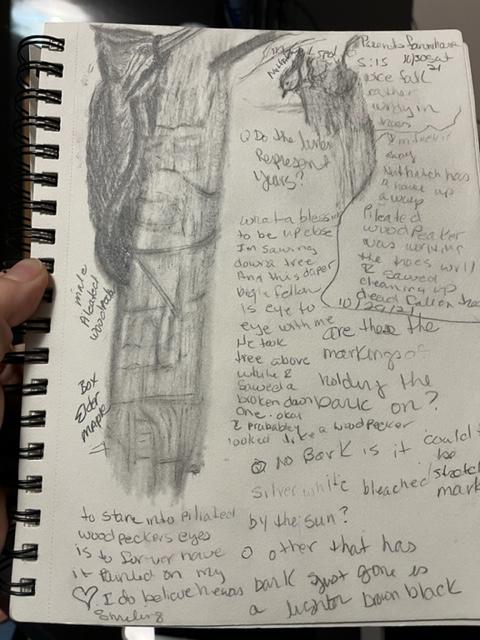The Cornell Lab Bird Academy › Discussion Groups › Nature Journaling and Field Sketching › Noticing Themes in Nature
-
Since beginning to bird, I've been going back to same park at least once a month. I can see how the type and number of birds change as the seasons progress.
-
April 10, 2023, northeastern Connecticut. Observations: While I was out on my first "sit spot" excursion, I found two bird species that shared an unusual behavior, and a third species that did something similar, but not exactly the same. I only saw about six species of birds, and for three of them to catch my eye in this way was, well, eye-catching. The Louisiana Waterthrush and the Palm Warbler have just returned from winter in the neotropics, and the Eastern Phoebe has been back for a couple of weeks already. The Waterthrush and this particular warbler are both tail-bobbers and the phoebe is a tail-wagger. The phoebe sits very upright (flicking its tail) and hunts for flying insects from perches in trees. The other two species hold their bodies in a rather horizontal posture and bob their entire back end up and down - they forage either on the ground or from low branches, where they are hunting for various invertebrates. Possible explanations: Does it have to do with the hunting behavior? does it scare up insects? does it give the bird a different perspective by changing the angle at which it views the ground for potential prey? And while we're at it - it's a whole different mechanical action! the phoebe must be using just a few muscles that activate the tail and the waterthrush and warbler use the hip and leg joints, which I suppose would require a little more energy. Further questions: I'm hoping some ornithology graduate student somewhere has taken slow-motion video and analyzed the body motion and the gaze of the bird and the activity of insects around the bird - and already answered my question. But what's weird, is that I saw them all in one outing, and this behavior is not widespread among little songbirds. So, further questions, which other birds do this? and what does the research show?
-
As a frequent "forest bather" (we are fortunate to live at the base of a mountain that is protected and open for wanderings) I have wondered about a lot of the themes you have mentioned here without realizing that's what I was doing. For instance, every spring beavers show up on our creek and take down a few small trees. We have wondered where they're lodging. If they were damming up this creek we would see massive flooding. So how far are they traveling to harvest these trees? And then again since we've never actually seen them could it be a different animal? I don't know of any other that cuts saplings down quite like this. We have pink lady slippers growing on this mountain. Some years they appear. Others they don't. I've wondered why. Is something eating the bulbs/root systems? Do the conditions required for their thriving change? I know they prefer soil around fallen pine trees but now what else can I observe about them? ' Just two of my wonderings. I appreciate this explanation of themes in the natural world. I have noted them in my journal and intend to revisit them with each trip I make into the wild and wonderful world we live in.
-
 I
I -
Your goldfinch is awesome!
-
@Donita Yup. This is amazing!
-
-

 Me and my sister looked at birds in are yard and we noticed a few forms and functions and noticed some changes.
Me and my sister looked at birds in are yard and we noticed a few forms and functions and noticed some changes.
-
This particular concept of Noticing the themes, I personally prefer is a continuous process of our observations. I think while observing any particular species or nature in general. Especially when we do bird watching, most of these themes are observed, explained, and questioned. But the only thing is when we put it in Journal, we need to really add all these in detail. Thanks which I am learning now to add to my journal. Scale and Quantity, forms, and functions are very essential themes that most of us observe, and for me, the new learning about noticing the change, especially the beaver dam was eye-opening. Your Mushroom example for the ecosystems was always surprising or magical in my childhood which I never gave so much thought to at that age. Now after starting this nature journal it's taking me back to those scientific explanations and the need to understand their importance. Currently, i do not have an image for this, will try to work on all five themes and upload it.
-
 I found myself journaling at 4:18 pm. The sun had not set but it was dusk and a half moon sat in the sky. American robins were noisily chatting to each other with an occasional alarm (?) call. There were 2 Anna's hummingbirds flying between a bare large leaf maple and a Douglas fir. A northern flicker gave a few shrill calls and fell silent for the duration. American crows could be heard in the distance but were not present where I sat. I was surprised to find I have been misidentifying the fox sparrow as a song sparrow - according to MerlinID. Since this is winter, the birds were using calls not songs so I needed the help of Merlin to identify the birds I could not see. The robins were very active flying tree to tree and calling to each other. The sparrows were concealed in a Laurel hedge. Interesting to find the robins in the trees. In the early morning I see them in large flocks in the short grass. The robins sat in the trees with their wings hung low as pictured. It was a common trait I found with most of the robins sitting in the trees.
I found myself journaling at 4:18 pm. The sun had not set but it was dusk and a half moon sat in the sky. American robins were noisily chatting to each other with an occasional alarm (?) call. There were 2 Anna's hummingbirds flying between a bare large leaf maple and a Douglas fir. A northern flicker gave a few shrill calls and fell silent for the duration. American crows could be heard in the distance but were not present where I sat. I was surprised to find I have been misidentifying the fox sparrow as a song sparrow - according to MerlinID. Since this is winter, the birds were using calls not songs so I needed the help of Merlin to identify the birds I could not see. The robins were very active flying tree to tree and calling to each other. The sparrows were concealed in a Laurel hedge. Interesting to find the robins in the trees. In the early morning I see them in large flocks in the short grass. The robins sat in the trees with their wings hung low as pictured. It was a common trait I found with most of the robins sitting in the trees. -

-
I don't have a journal page really reflecting this yet, but I notice I tend to focus on scale/quantity-- especially quantity. Numbers that I can count. Hard data. One thing I'd like to use this nature journaling for is to allow myself to begin exploring other themes. I'm really interested in observing energy flow and change in the natural areas of the farm I live on.
-
 I noticed that the scaups I saw yesterday and the Ring Necked ducks today are hard to distinguish from each other. They have very similar coloring of white and dark.
The large white bellies and white patches on its body (male) make it blend into the reflection of the water.
The black helps blend as shadows.
Scaups and Ring Neck ducks are closely related and occupy the same niche.
Will Scaups and Ring Neck ducks occupy the same area?
Can there only be one type of diving and one type of non-diving duck in a certain sized area?
Do these ducks hybridize? Scaups and Ring Neck?
I noticed that the scaups I saw yesterday and the Ring Necked ducks today are hard to distinguish from each other. They have very similar coloring of white and dark.
The large white bellies and white patches on its body (male) make it blend into the reflection of the water.
The black helps blend as shadows.
Scaups and Ring Neck ducks are closely related and occupy the same niche.
Will Scaups and Ring Neck ducks occupy the same area?
Can there only be one type of diving and one type of non-diving duck in a certain sized area?
Do these ducks hybridize? Scaups and Ring Neck?
-
I usually see many deer and their fawns on our nature walks, so I chose this white-tailed deer fawn for my theme. I also love learning about patterns!

-
 Why are all the aspens looking at me? Beautiful eyes on many trees. Finally I realize that they are the places of empty branches that have sprouted from the trunk, died, and been healed by the tree. When the healing process doesn't go as well, dark patches of scar tissue and dripping flesh appear on the trunk. I welcome the diversity of eyes which watch the forest for me when I am not there.
Why are all the aspens looking at me? Beautiful eyes on many trees. Finally I realize that they are the places of empty branches that have sprouted from the trunk, died, and been healed by the tree. When the healing process doesn't go as well, dark patches of scar tissue and dripping flesh appear on the trunk. I welcome the diversity of eyes which watch the forest for me when I am not there. -
I so love this post. I tend to see cat faces in the limbs and scars of winter trees. Also have a couple of old men trees that I visit to look at their bulbous noses and seek out the remains of their eye sockets in the fold of the bark. Isn't nature a marvel.
-
-
In the late afternoon/evening, I watch the ruby-throated hummingbirds at the feeders I’ve hung. (They’re most active in mid-morning, and early evening.) They like the red-colored plastic feeder, near the butterfly bush, and the multi-colored glass feeder, which is near the wisteria. None of them like the plain glass feeder with a white base, which is near the hanging baskets of flowers that they do like. One female, in particular, regularly sits on the wisteria branch watching over the multi-colored feeder. Just as soon as another hummingbird approaches to get a sip, she buzzes her away, though she herself doesn’t seem hungry. Are hummingbirds territorial? What is the benefit to protecting this feeder so fiercely? I don’t know if there are families of hummingbirds, so perhaps they’re protecting for their babies? There seems to be one male, and several females who regularly visit. It seems the females are the ones who fight the most. Sometimes, I see two or three of them chasing each other around. It seems to use a lot of energy as they dart and dive above the pergola. Is the energy expense worth it? There’s plenty of food — between the flowers in the hanging baskets, the wisteria, the butterfly bush, and the hibiscus, as well as the three feeders and the insects.
-
 I think this natural journal of mine includes "Patterns" in it.
Observation: Sparrows sometimes scratch their heads.
Possible explanations: 1. The sparrows have parasites on their heads, so the sparrows scratch their heads to clean up the parasites.
2. Many animals (eg dogs) also scratch their heads, perhaps genetically.
3. Just to groom the feathers.
Question: Bird scratching its head seems simple, but we humans can't do it, why is this? If birds scratch their heads because they have parasites on their heads, can birds scratch their heads to reduce parasites?
I think this natural journal of mine includes "Patterns" in it.
Observation: Sparrows sometimes scratch their heads.
Possible explanations: 1. The sparrows have parasites on their heads, so the sparrows scratch their heads to clean up the parasites.
2. Many animals (eg dogs) also scratch their heads, perhaps genetically.
3. Just to groom the feathers.
Question: Bird scratching its head seems simple, but we humans can't do it, why is this? If birds scratch their heads because they have parasites on their heads, can birds scratch their heads to reduce parasites? -
 I feel like my nature journal includes "scale and quantity".
Observation: Sparrows like to flock for food, but turtledoves do not.
Possible explanations: 1. Sparrows are small and vulnerable to predators. So they gather together to find food, which can distract predators, in fact, there are many animals in nature who like to gather together. 2. Turtledoves have fewer natural enemies, so they are often alone.
Question: Does the "gut" of a bird have anything to do with the size of the bird? Do sparrows forage alone or with other birds when there are no companions?
I feel like my nature journal includes "scale and quantity".
Observation: Sparrows like to flock for food, but turtledoves do not.
Possible explanations: 1. Sparrows are small and vulnerable to predators. So they gather together to find food, which can distract predators, in fact, there are many animals in nature who like to gather together. 2. Turtledoves have fewer natural enemies, so they are often alone.
Question: Does the "gut" of a bird have anything to do with the size of the bird? Do sparrows forage alone or with other birds when there are no companions? -
I recognised the theme "Systems and Flow" in my sit spot and on my journal page (posted again here, sorry). Where else do the Rainbow Lorikeets go to eat and rest in unusually cold and wet conditions? How do they find food when it's too wet for nectar? What food do they find? Do these conditions cause loss of Lorikeet life? Can this be measured?

-
I'm looking out onto our backyard and considering the blossoms on the apple, summer pear and winter pear, and plum trees. I pruned the apple tree quite hard this year and see that some of the cut branches have new leaves but no blossoms. There are scant blossoms on the apple compared to the summer pear. The summer pear has the most and looks healthier, however, is that just because of it having more blossoms? Last year, the apple produced far more fruit than either pear tree, and the plum tree did well, too. Yet, the plum tree doesn't have any blossoms on it yet. Do they come out later? All of the blossoms are predominantly white, with a pink centre. The blossom petals are light and when falling to the ground, they rest on top of the grass. They are still fresh and still white, however, I know they will start to turn brown. What is it that makes a petal white, and once it falls, it decays to brown? Small birds have been enjoying the blossoms, and when I get closer I see bees are too. When we get a strong south easterly wind the blossoms will fall. They'll be gone soon, but for now, they grace the trees and make me think of weddings :)
-
Yes when I use a sit spot and look, listen, and feel what is around me I find I notice more things and this makes me wonder, ask more questions and see things with "awe". Some of the things I have seen, wondered about, enjoyed and researched due to questions that have developed are what makes a whirlpool in a stream or river and how dangerous are they. Why are the white butterflies flying low over my lawn over and over again? Are they looking for food? Are evergreen trees able to take in water and nutrients through their needles? What bacteria is in my garden soil? Why are Nuthatches dominant over Chickadees? A very helpful exercise.
-
As I sat at my desk thinking what to choose for my subject, it presented itself with a rustle. Namely, I have a Maranta plant in my room and every now and then its leaves will move making a rustling sound!
 While observing my Maranta's leaves in the afternoon and evening I noticed the change in their position and that there is a pattern to their movement: upward during the night and downward during the day. I also noticed the drastic difference in color between the top and bottom side of the leaves. I noted my observations and the possible explanations (one of several theories which states that they move upward to conserve moisture). I ended up with the following questions: What other theories about the leaf movement are there? It is usually the top part of a leaf that is more intensely pigmented so as to trap more light energy, while the bottom is less pigmented and lighter. Does the dark red bottom side of the Maranta leaf have a hidden function?
While observing my Maranta's leaves in the afternoon and evening I noticed the change in their position and that there is a pattern to their movement: upward during the night and downward during the day. I also noticed the drastic difference in color between the top and bottom side of the leaves. I noted my observations and the possible explanations (one of several theories which states that they move upward to conserve moisture). I ended up with the following questions: What other theories about the leaf movement are there? It is usually the top part of a leaf that is more intensely pigmented so as to trap more light energy, while the bottom is less pigmented and lighter. Does the dark red bottom side of the Maranta leaf have a hidden function? -
Exploring: Form and Function Bird Beaks of three birds that were observed in our wetland!

-
Awesome! I love the way you wrapped the text.
-
-
 Observation: Starlings' murmuring is very much like sardine baitballs.
Possible Explanation: Both animals have adapted as prey to partake in safety in numbers.
Question: Why have two different animal classes adapted such similar behaviors?
Observation: Starlings' murmuring is very much like sardine baitballs.
Possible Explanation: Both animals have adapted as prey to partake in safety in numbers.
Question: Why have two different animal classes adapted such similar behaviors? -
love the image, love the thought. didn't know about bait balls
-
-


-
 Observations of Hairy and Downy Woodpeckers at our feeders; what they do and why they may do it, and reasons they might have similar coloring.
Observations of Hairy and Downy Woodpeckers at our feeders; what they do and why they may do it, and reasons they might have similar coloring. -

-
I was exploring and questioning the relationship of flowers to pollinators on these pages. I also documented a predatory introduced wasp eating leaf miner caterpillars.

-
love how you've captured wasps...a sense of delicate and strong. Are you using watercolour or coloured pencils?
-
Read More:
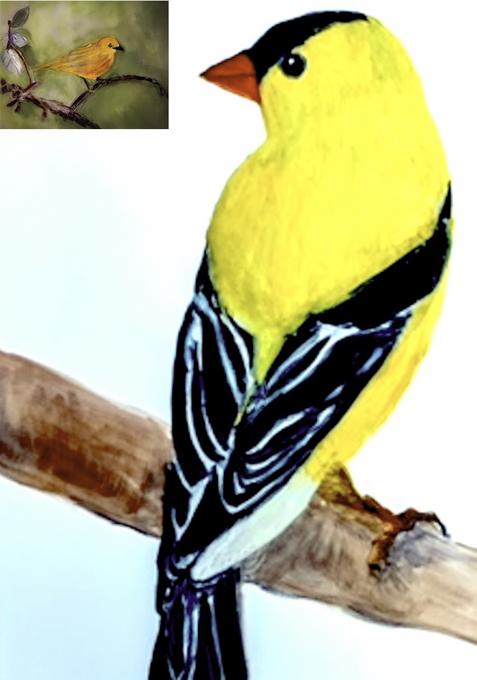 I
I 
 Me and my sister looked at birds in are yard and we noticed a few forms and functions and noticed some changes.
Me and my sister looked at birds in are yard and we noticed a few forms and functions and noticed some changes. I found myself journaling at 4:18 pm. The sun had not set but it was dusk and a half moon sat in the sky. American robins were noisily chatting to each other with an occasional alarm (?) call. There were 2 Anna's hummingbirds flying between a bare large leaf maple and a Douglas fir. A northern flicker gave a few shrill calls and fell silent for the duration. American crows could be heard in the distance but were not present where I sat. I was surprised to find I have been misidentifying the fox sparrow as a song sparrow - according to MerlinID. Since this is winter, the birds were using calls not songs so I needed the help of Merlin to identify the birds I could not see. The robins were very active flying tree to tree and calling to each other. The sparrows were concealed in a Laurel hedge. Interesting to find the robins in the trees. In the early morning I see them in large flocks in the short grass. The robins sat in the trees with their wings hung low as pictured. It was a common trait I found with most of the robins sitting in the trees.
I found myself journaling at 4:18 pm. The sun had not set but it was dusk and a half moon sat in the sky. American robins were noisily chatting to each other with an occasional alarm (?) call. There were 2 Anna's hummingbirds flying between a bare large leaf maple and a Douglas fir. A northern flicker gave a few shrill calls and fell silent for the duration. American crows could be heard in the distance but were not present where I sat. I was surprised to find I have been misidentifying the fox sparrow as a song sparrow - according to MerlinID. Since this is winter, the birds were using calls not songs so I needed the help of Merlin to identify the birds I could not see. The robins were very active flying tree to tree and calling to each other. The sparrows were concealed in a Laurel hedge. Interesting to find the robins in the trees. In the early morning I see them in large flocks in the short grass. The robins sat in the trees with their wings hung low as pictured. It was a common trait I found with most of the robins sitting in the trees. 
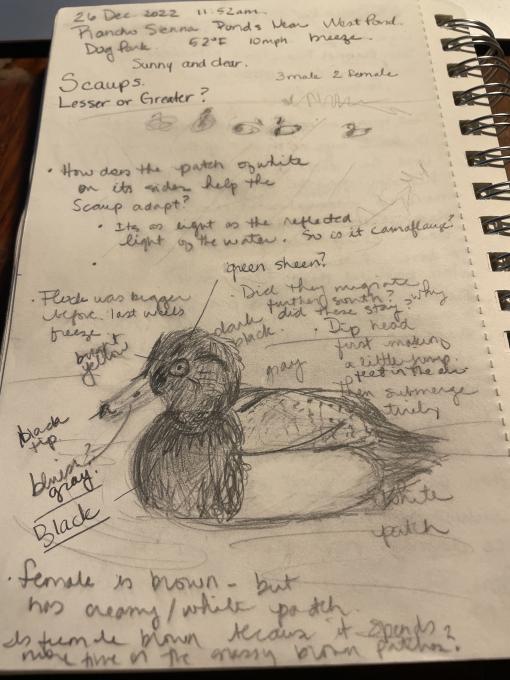 I noticed that the scaups I saw yesterday and the Ring Necked ducks today are hard to distinguish from each other. They have very similar coloring of white and dark.
The large white bellies and white patches on its body (male) make it blend into the reflection of the water.
The black helps blend as shadows.
Scaups and Ring Neck ducks are closely related and occupy the same niche.
Will Scaups and Ring Neck ducks occupy the same area?
Can there only be one type of diving and one type of non-diving duck in a certain sized area?
Do these ducks hybridize? Scaups and Ring Neck?
I noticed that the scaups I saw yesterday and the Ring Necked ducks today are hard to distinguish from each other. They have very similar coloring of white and dark.
The large white bellies and white patches on its body (male) make it blend into the reflection of the water.
The black helps blend as shadows.
Scaups and Ring Neck ducks are closely related and occupy the same niche.
Will Scaups and Ring Neck ducks occupy the same area?
Can there only be one type of diving and one type of non-diving duck in a certain sized area?
Do these ducks hybridize? Scaups and Ring Neck?
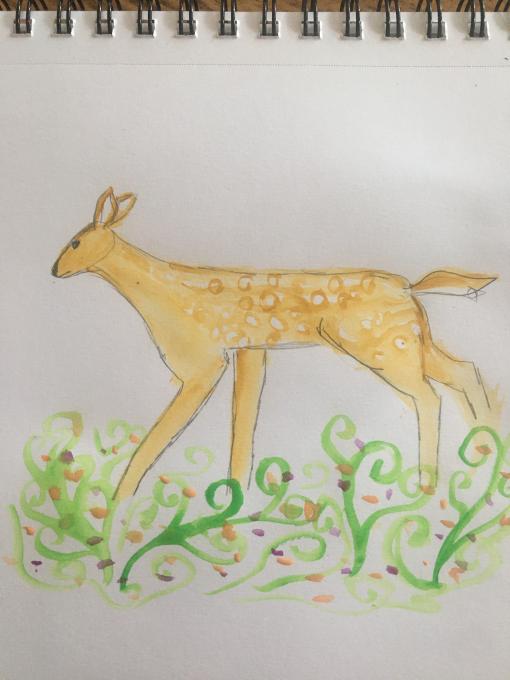
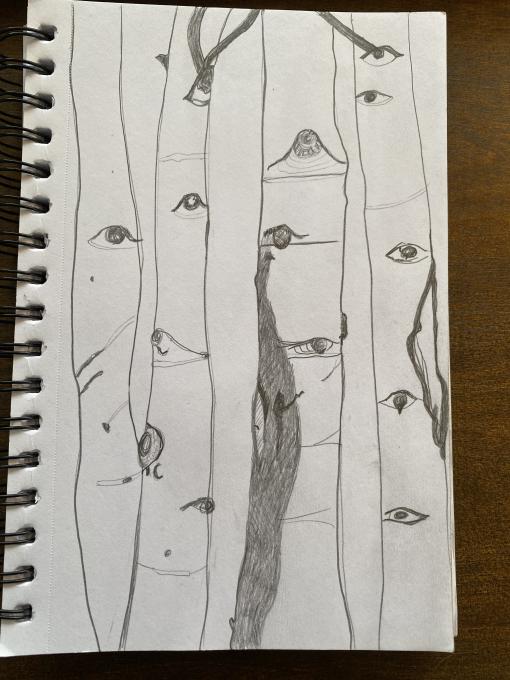 Why are all the aspens looking at me? Beautiful eyes on many trees. Finally I realize that they are the places of empty branches that have sprouted from the trunk, died, and been healed by the tree. When the healing process doesn't go as well, dark patches of scar tissue and dripping flesh appear on the trunk. I welcome the diversity of eyes which watch the forest for me when I am not there.
Why are all the aspens looking at me? Beautiful eyes on many trees. Finally I realize that they are the places of empty branches that have sprouted from the trunk, died, and been healed by the tree. When the healing process doesn't go as well, dark patches of scar tissue and dripping flesh appear on the trunk. I welcome the diversity of eyes which watch the forest for me when I am not there.  I think this natural journal of mine includes "Patterns" in it.
Observation: Sparrows sometimes scratch their heads.
Possible explanations: 1. The sparrows have parasites on their heads, so the sparrows scratch their heads to clean up the parasites.
2. Many animals (eg dogs) also scratch their heads, perhaps genetically.
3. Just to groom the feathers.
Question: Bird scratching its head seems simple, but we humans can't do it, why is this? If birds scratch their heads because they have parasites on their heads, can birds scratch their heads to reduce parasites?
I think this natural journal of mine includes "Patterns" in it.
Observation: Sparrows sometimes scratch their heads.
Possible explanations: 1. The sparrows have parasites on their heads, so the sparrows scratch their heads to clean up the parasites.
2. Many animals (eg dogs) also scratch their heads, perhaps genetically.
3. Just to groom the feathers.
Question: Bird scratching its head seems simple, but we humans can't do it, why is this? If birds scratch their heads because they have parasites on their heads, can birds scratch their heads to reduce parasites? 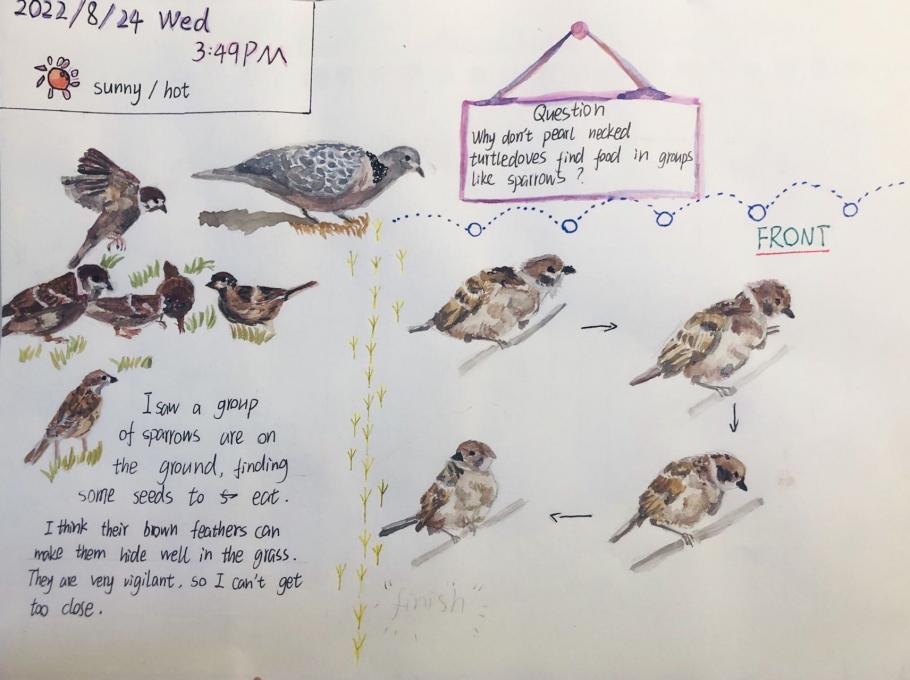 I feel like my nature journal includes "scale and quantity".
Observation: Sparrows like to flock for food, but turtledoves do not.
Possible explanations: 1. Sparrows are small and vulnerable to predators. So they gather together to find food, which can distract predators, in fact, there are many animals in nature who like to gather together. 2. Turtledoves have fewer natural enemies, so they are often alone.
Question: Does the "gut" of a bird have anything to do with the size of the bird? Do sparrows forage alone or with other birds when there are no companions?
I feel like my nature journal includes "scale and quantity".
Observation: Sparrows like to flock for food, but turtledoves do not.
Possible explanations: 1. Sparrows are small and vulnerable to predators. So they gather together to find food, which can distract predators, in fact, there are many animals in nature who like to gather together. 2. Turtledoves have fewer natural enemies, so they are often alone.
Question: Does the "gut" of a bird have anything to do with the size of the bird? Do sparrows forage alone or with other birds when there are no companions? 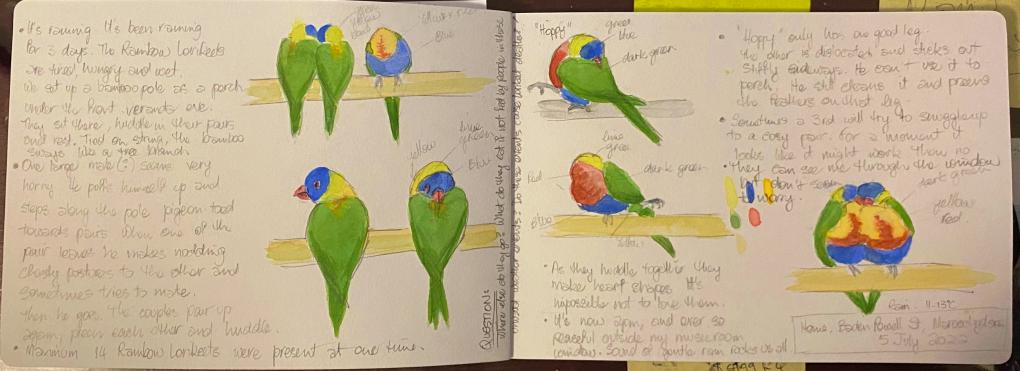
 While observing my Maranta's leaves in the afternoon and evening I noticed the change in their position and that there is a pattern to their movement: upward during the night and downward during the day. I also noticed the drastic difference in color between the top and bottom side of the leaves. I noted my observations and the possible explanations (one of several theories which states that they move upward to conserve moisture). I ended up with the following questions: What other theories about the leaf movement are there? It is usually the top part of a leaf that is more intensely pigmented so as to trap more light energy, while the bottom is less pigmented and lighter. Does the dark red bottom side of the Maranta leaf have a hidden function?
While observing my Maranta's leaves in the afternoon and evening I noticed the change in their position and that there is a pattern to their movement: upward during the night and downward during the day. I also noticed the drastic difference in color between the top and bottom side of the leaves. I noted my observations and the possible explanations (one of several theories which states that they move upward to conserve moisture). I ended up with the following questions: What other theories about the leaf movement are there? It is usually the top part of a leaf that is more intensely pigmented so as to trap more light energy, while the bottom is less pigmented and lighter. Does the dark red bottom side of the Maranta leaf have a hidden function? 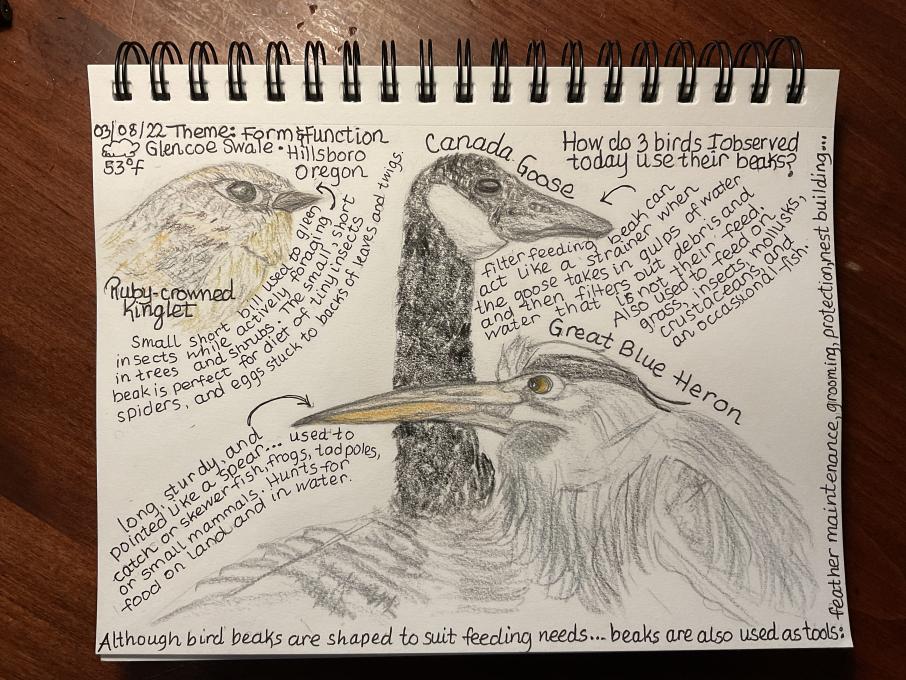
 Observation: Starlings' murmuring is very much like sardine baitballs.
Possible Explanation: Both animals have adapted as prey to partake in safety in numbers.
Question: Why have two different animal classes adapted such similar behaviors?
Observation: Starlings' murmuring is very much like sardine baitballs.
Possible Explanation: Both animals have adapted as prey to partake in safety in numbers.
Question: Why have two different animal classes adapted such similar behaviors? 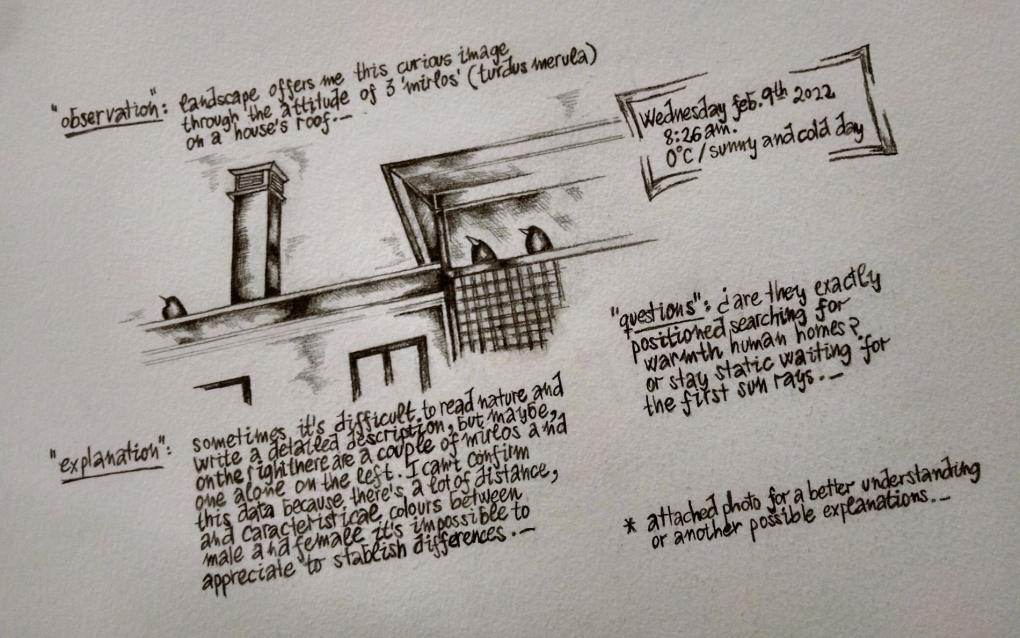
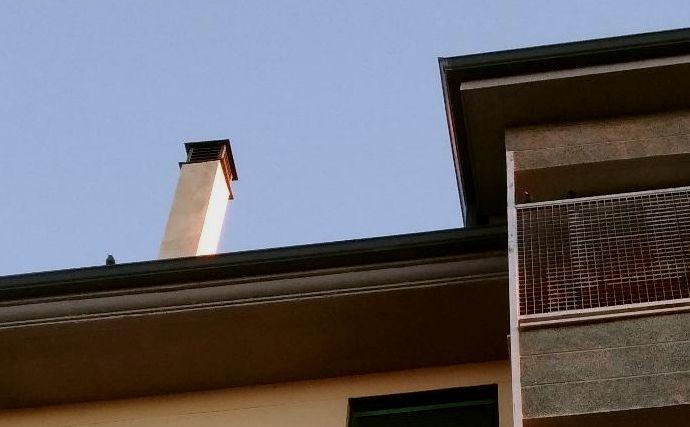
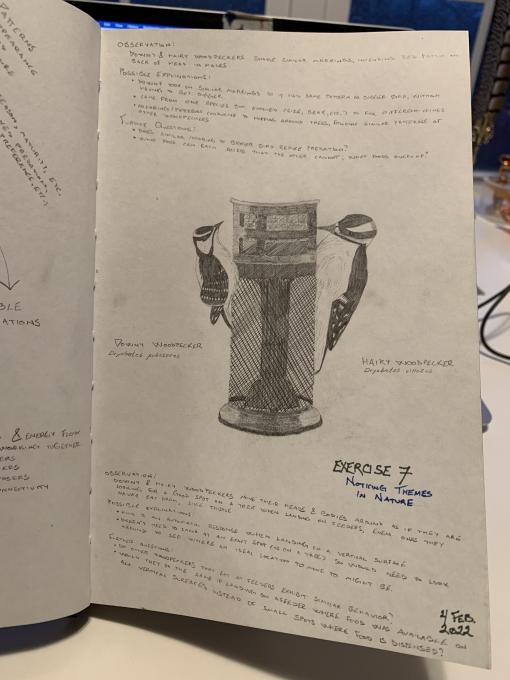 Observations of Hairy and Downy Woodpeckers at our feeders; what they do and why they may do it, and reasons they might have similar coloring.
Observations of Hairy and Downy Woodpeckers at our feeders; what they do and why they may do it, and reasons they might have similar coloring. 